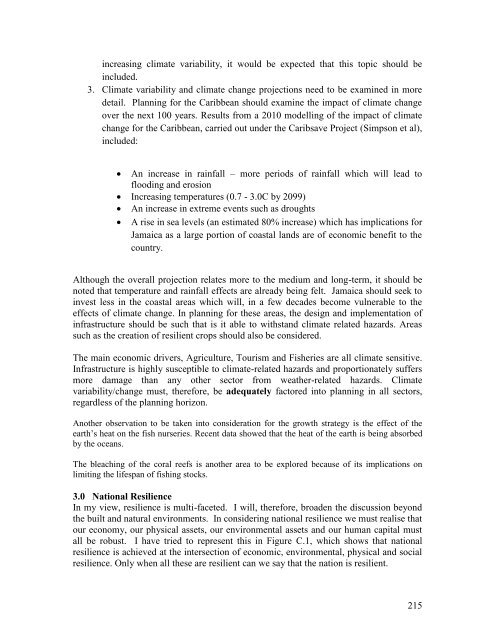PIOJ Growth-Inducement Strategy - Planning Institute of Jamaica
PIOJ Growth-Inducement Strategy - Planning Institute of Jamaica
PIOJ Growth-Inducement Strategy - Planning Institute of Jamaica
Create successful ePaper yourself
Turn your PDF publications into a flip-book with our unique Google optimized e-Paper software.
increasing climate variability, it would be expected that this topic should be<br />
included.<br />
3. Climate variability and climate change projections need to be examined in more<br />
detail. <strong>Planning</strong> for the Caribbean should examine the impact <strong>of</strong> climate change<br />
over the next 100 years. Results from a 2010 modelling <strong>of</strong> the impact <strong>of</strong> climate<br />
change for the Caribbean, carried out under the Caribsave Project (Simpson et al),<br />
included:<br />
An increase in rainfall – more periods <strong>of</strong> rainfall which will lead to<br />
flooding and erosion<br />
Increasing temperatures (0.7 - 3.0C by 2099)<br />
An increase in extreme events such as droughts<br />
A rise in sea levels (an estimated 80% increase) which has implications for<br />
<strong>Jamaica</strong> as a large portion <strong>of</strong> coastal lands are <strong>of</strong> economic benefit to the<br />
country.<br />
Although the overall projection relates more to the medium and long-term, it should be<br />
noted that temperature and rainfall effects are already being felt. <strong>Jamaica</strong> should seek to<br />
invest less in the coastal areas which will, in a few decades become vulnerable to the<br />
effects <strong>of</strong> climate change. In planning for these areas, the design and implementation <strong>of</strong><br />
infrastructure should be such that is it able to withstand climate related hazards. Areas<br />
such as the creation <strong>of</strong> resilient crops should also be considered.<br />
The main economic drivers, Agriculture, Tourism and Fisheries are all climate sensitive.<br />
Infrastructure is highly susceptible to climate-related hazards and proportionately suffers<br />
more damage than any other sector from weather-related hazards. Climate<br />
variability/change must, therefore, be adequately factored into planning in all sectors,<br />
regardless <strong>of</strong> the planning horizon.<br />
Another observation to be taken into consideration for the growth strategy is the effect <strong>of</strong> the<br />
earth’s heat on the fish nurseries. Recent data showed that the heat <strong>of</strong> the earth is being absorbed<br />
by the oceans.<br />
The bleaching <strong>of</strong> the coral reefs is another area to be explored because <strong>of</strong> its implications on<br />
limiting the lifespan <strong>of</strong> fishing stocks.<br />
3.0 National Resilience<br />
In my view, resilience is multi-faceted. I will, therefore, broaden the discussion beyond<br />
the built and natural environments. In considering national resilience we must realise that<br />
our economy, our physical assets, our environmental assets and our human capital must<br />
all be robust. I have tried to represent this in Figure C.1, which shows that national<br />
resilience is achieved at the intersection <strong>of</strong> economic, environmental, physical and social<br />
resilience. Only when all these are resilient can we say that the nation is resilient.<br />
215
















